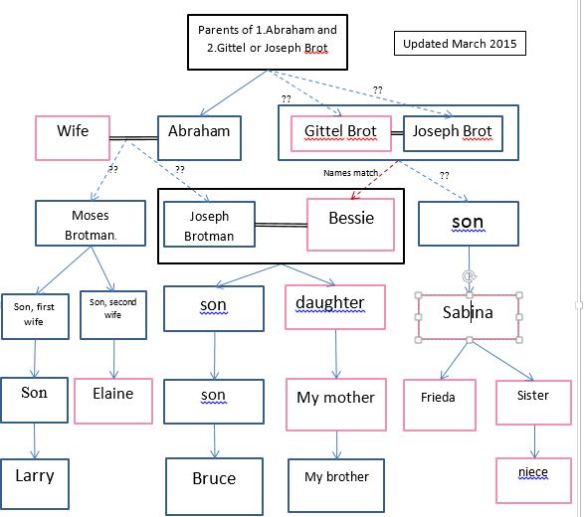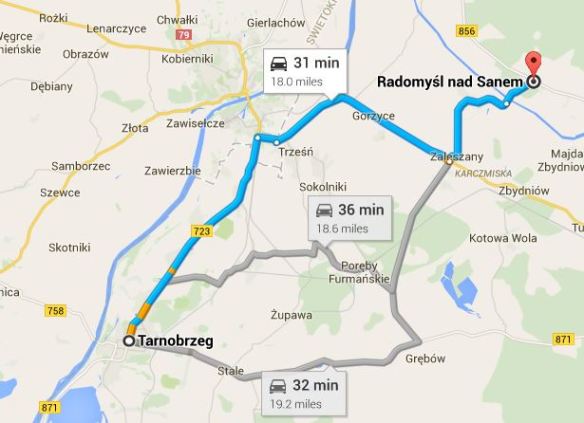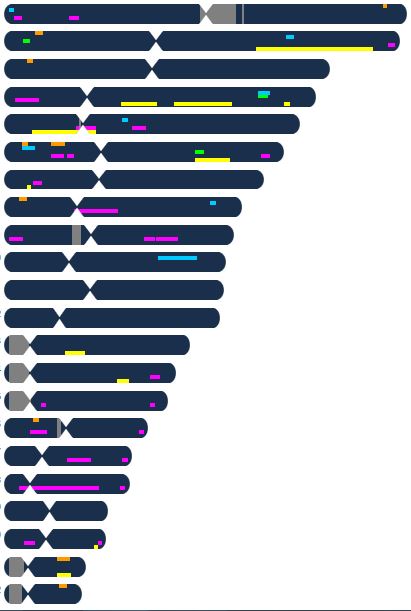Lately I have been drowning in DNA. I am trying to figure out how to interpret the DNA results I have and make use of them in searching for my ancestors. Specifically, my Brotman ancestors. As I look forward to visiting Poland in May and seeing Tarnobrzeg, I more and more want to be able to find something that actually corroborates my conclusion that that was the general area where my great-grandparents Joseph and Bessie Brotman lived. I was hoping that perhaps with DNA results, I’d find another clue, another cousin, who knew something I didn’t know.

Animation of the structure of a section of DNA. The bases lie horizontally between the two spiraling strands. (Photo credit: Wikipedia)
So I dove into the DNA. When I last wrote about the DNA tests, I talked about the fact that the autosomal DNA results supported the story my aunt had told about Joseph Brotman and his brother who had moved to New Jersey where they named the town for him, i.e., Brotmanville. Moses Brotman’s granddaughter Elaine tested as a likely second cousin to my mother, just as she would be if Moses and Joseph were brothers. I am still waiting for results of an autosomal DNA test of Larry, who is a great-grandson of Moses Brotman, for further support (I hope) for that conclusion. But sadly the Brotmanville Brotmans are also not clear on where Moses lived or was born in Galicia. Family stories suggest Preszyml, which isn’t too far from Tarnobrzeg (about 90 miles), but there is no paper record to support that story either. They also do not have any records or stories about the parents or siblings of Moses Brotman.
But the DNA results also produced an unknown likely second cousin for my mother named Frieda. Frieda’s niece and I have been in touch, and we have narrowed down the possibilities of the connection. We believe that the connection is through Frieda’s mother whose name was Sabina Brot. We think that Sabina’s father might have been Bessie Brotman’s brother. Here is a chart that helps to visualize the potential relationships:
Again, there is no paper trail, but this is how we reached that tentative conclusion:
First, not only did my mother test as a second cousin to Frieda, but my brother tested as a second to fourth cousin to Frieda. But Elaine, the granddaughter of Moses, tested as a third to fifth cousin to Frieda, meaning that Frieda shared more DNA with my mother and my brother than she did with Elaine. Since Elaine would be more closely related to Joseph than she would be to Bessie,[1] I inferred that Frieda was more likely connected to my mother through Bessie, not Joseph. (Keep in mind that Joseph and Bessie were supposedly first cousins, so even Elaine could share some DNA with Bessie from Bessie and Joseph’s mutual grandparents, Elaine’s great-great-grandparents.)
At the suggestion of Frieda’s niece, I then ordered an mtDNA test on my mother’s kit to see if she and Frieda were in the same haplogroup. As defined by the International Society of Genetic Genealogy (ISOGG), “A haplogroup is a genetic population group of people who share a common ancestor on the patrilineal or matrilineal line.” Mitochondrial DNA (mtDNA) is only passed by mothers to their children. Although sons inherit mtDNA from their mothers, they do not pass it down to their children. Thus, mtDNA is a way of testing the maternal line—from mothers to daughters and so on. If Frieda and my mother were not in the same haplogroup, we would be able to infer that the connection had not come from Frieda’s grandmother as a sister of Bessie, but more likely from Frieda’s grandfather. As it turned out, my mother was not in the same haplogroup as Frieda, meaning Frieda’s mother (Sabina)’s mother was not the connection to my mother’s mother’s mother. Thus, we concluded that if my mother and Frieda are second cousins, it was most likely that Bessie, my mother’s grandmother, and Frieda’s grandfather were siblings.
If only Frieda knew the name of her grandfather or the town where he lived, we could make some progress. But unfortunately, Frieda’s family knows almost nothing about the background of Sabina Brot or her parents, so we are once again at an impasse. Frieda’s niece believes Sabina lived in Radomysl nad Sanem, a town not far at all from Tarnobrzeg.
I put aside the DNA at that point, figuring I’d done what I could do. I emailed a few other “matches” on FamilyTreeDNA, and I received a few responses. But no one had any helpful information or anything that seemed like a possible link to my family.
Then I decided to try and get more out of the results. I asked a lot of questions in various Facebook genealogy groups, read a lot of blogs and websites, but was still without a clue. I tried a program called DNAgedcom, which has a tool known as ADSA that allows you to see who else matches your kit on a specific chromosome and who else matches with that person. It is a great tool, but unfortunately DNAgedcom is not yet equipped to handle the large number of matches that most Ashkenazi Jews will generate through autosomal DNA testing.
As I’ve learned, and as I’ve seen in my own family on several lines, Ashkenazi Jews are an endogamous population, meaning that they tended to marry within their own community and even within their own families. Thus, a typical Ashkenazi Jew will share some bits of DNA with thousands of other Ashkenazi Jews. My mother had thousands of matches, but most of them are so distantly related as to be irrelevant. As was recently stated in one report, some researchers believe that all Ashkenazi Jews are descended from several hundred Jews who lived about 600 years ago. So we are, in fact, all one big tribe.
That’s all well and good until you want to use DNA to find closer relatives. For DNAgedcom, it was just too much data. Their website estimates that a typical download will take about 30 minutes. My mother’s data was still downloading after SIX hours, and it wasn’t nearly done. In fact, it crashed and never completely downloaded.
Then people told me to try GEDmatch, another website for interpreting DNA results. I sent the data to GEDmatch for my mother, brother, Bruce, and Elaine, and Frieda’s niece sent Frieda’s data. Then I had no clue what to do with GEDmatch. Like DNAgedcom, it’s a free site run by wonderful people who are interested in genealogical uses of DNA. But free means you can’t complain when things aren’t clear or you can’t figure something out. I was totally perplexed by GEDmatch. Lots of numbers, lots of charts. But what did they all mean? And how could I use them to interpret the DNA results or find new matches?
Here’s a portion of one page of many showing (with identifying information deleted) some of my mother’s matches on GEDmatch:
Yeah, right? What does all THAT mean?
Back to the Facebook groups I went, and this time I found three incredible women, Julie, Leah, and Lana, who volunteered to help me figure out how to use the DNA results and the various tools available. Together they have backgrounds in biology and IT and math. We created our own space on Facebook to work together. Well, mostly they worked, and I learned. Am still learning. They are amazing. We have spent hours and hours online together despite the fact that we are spread across two continents and many times zones.
What I have learned? To begin with, I now understand how DNA is affected during the process of meiosis, that is, the creation of gametes, i.e., sperm and egg. I won’t show off here, though I do wonder what my high school biology was teaching us since I never learned this. The bottom line is that DNA changes during meiosis when segments of the chromosomes “cross over” and then randomly sort themselves before the cell splits into ultimately four new cells, each with a unique selection of DNA on the chromosomes contained therein. As a result, two children with the exact same parents will not have identical DNA since the sperm and egg that created the first sibling will have different DNA than the sperm and egg that created the second sibling. (This may explain why my brother has the science brain and I, quite obviously, do not. I am sure he and others will gladly point out anything that is not correct about this description.)
Here’s a cute video that I found helpful:
Why is any of that relevant to using DNA for genealogy? Because it means that even siblings will share varying amounts of DNA and different DNA. It’s not only that every generation has new parents mixing into their offspring’s DNA; it’s also that each parent shares different DNA with each child. And with each generation there are more crossovers, more sortings, and thus more differences. So when two people share a fairly large amount of overall DNA and also some large segments of DNA, it is quite reliable as an indication of a familial relationship. Given all the crossovers and mixing and new DNA with every generation, it’s not likely that two people would share a lot of DNA unless they were related.
I won’t go into all the statistics and terminology. That’s not my goal here. I just wanted to explain why I’ve found these three women so helpful. I like to understand things, not just accept numbers without an explanation. And it didn’t stop with the science. My mentors then helped me figure out how to use GEDmatch to “triangulate.” No, not like Bill Clinton. In using DNA in genealogy, it helps to find out who shares DNA with you on a particular location on a particular chromosome. Then you need to figure out who among those people also share with each other. Thus, if A, B, and C share with me on Chromosome 12 at a given location for a certain segment, but A and B do not share with C, I know that C shares with me from a different parent than A and B. But I don’t know whether A and B share with the DNA I got from my mother or the DNA I got from my father.
Another thing I learned: I knew that chromosomes came in pairs, one from each parent for each of the 23 pairs of chromosomes. But I didn’t know that the testing companies don’t really distinguish one side from the other. They test two strands from each pair of chromosomes (one from each chromosome in that pair), but the two are jumbled together on the companies’ depictions of what is on that Chromosome 12 I mentioned above. What that means is that when I look at their depiction of a chromosome and see matches, I’ve no idea which parent’s strand that match pairs up with.

Human metaphase chromosomes were subjected to fluorescence in situ hybridization with a probe to the Alu Sequence (green signals)and counterstained for DNA (red). (Photo credit: Wikipedia)
For example, if you look at my brother’s chromosomes with my mother’s as a match, it looks like she matches all his DNA. All that orange is where she matches his DNA on his chromosomes. But in fact, that’s just half of his DNA. The DNA from my father isn’t reflected. All we are seeing is that my mother gave my brother half of his DNA.
In this case, we know that this is DNA from his mother because, well, I know she’s his mother. But when I look at someone else on my brother’s chromosomes, I don’t know if that person is matching the strand from my mother or my father unless I triangulate the three kits.
Here’s a more typical chromosome browser display with various matches:
Each color represents a different person who shares some DNA with my brother, and as you can see, there are some places where two colors overlap, like on the 21st chromosome. How do I know whether those people share DNA with my brother that comes from my mother or from my father? How do I know if those two overlapping people are related or just one shares my father’s DNA on the location and the other shares my mother’s DNA at that location? Triangulation. We have to figure out if those two people also share DNA with each other at that location and also whether they share with my mother at that particular location. And that’s what Leah, Lana, and Julie taught me to do.
Where has that gotten me? Well, we found that on Chromosome 21 my mother and Frieda had a large segment overlap with three other people. I then triangulated and found that all of them also matched Frieda and each other at that location on Chromosome 21. That means that they are all somehow related: Frieda, my mother, and A, B, and C all share a common ancestor who passed on this rather large segment that they all share. I don’t know for sure whether my mother got that segment from her mother or father, but since we have reason to believe that my mother and Frieda are connected through my great-grandmother’s Bessie’s family, it would seem that A, B, and C are also somehow related to my mother and Frieda through that family line.
So I emailed A, B, and C. I’ve heard back from two of them, but with nothing that’s very helpful. The little information each had showed nothing to explain this DNA connection. There are no common surnames and no common geographic locations. These two didn’t even have roots in Galicia that they knew of. Huh? Now what?
Good question. We are still tweaking the numbers, scouring other chromosomes, hoping something will provide a breakthrough. But at the moment I hold out limited hope that we will find someone who can connect all the pieces. It’s just too far back in a place where very few records survive and where surnames only started 200 years ago. Maybe A, B, and C had relatives who adopted different surnames, not Brot or Brotman. Maybe their great-great-grandfather moved to Ukraine or Lithuania or Latvia or mine moved away from there. We can speculate all we want, and the DNA doesn’t lie. But we may never, ever find the answer to how we are related.
So I have no better information today about where my great-grandparents lived or the names of their siblings or the names of earlier generations. But I know a lot more about DNA and about the tools out there for using it, thanks to Lana, Julie, and Leah.
***********************************
I will be taking a short break from the laptop—SPRING BREAK! (Now that I am retired, it’s not really my spring break, but years and years of celebrating it still has its effects.) See you soon.
For anyone who wants a broader introduction to DNA and chromosomes, Steve Morse (of stevemorse.org) wrote a very clear laymen’s overview of the topic here.
[1] Although Bruce, another great-grandchild of Joseph and Bessie, also tested as a third to fifth to Frieda, he shared more DNA with her than Elaine did, although he shared less than my brother did. In theory at least, Bruce and Ira should test as the same distance from Frieda, if she is related to us through Bessie. But DNA does not always pass on in equal segments, or so I’ve learned. Bruce might have more from Joseph’s side through his parents and grandparents than from Bessie’s side and my mother might have more.






Happy spring break, Amy! I hate to be this way, but DNA gets my migraine going. It’s exactly the type of math-like science that dulled my brain as a kid. I’m more the intuitive type person in math ;). On a related but unDNAish note, you aren’t related to any Brots who have lived in Kalamazoo, are you? Not Brotman, but Brot.
LikeLike
I also get that deer in headlights feel with math and science. But I think the only way I can get beyond the brick wall of my mother’s family is through DNA. So this has been a good challenge.
I’m not aware of any Brots anywhere who might be related, but anything is possible!
LikeLike
Pingback: Passover 2015: The American Jewish Story « Brotmanblog: A Family Journey